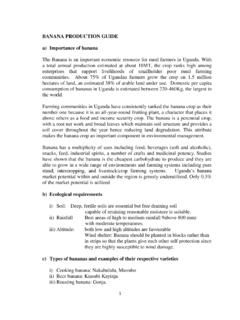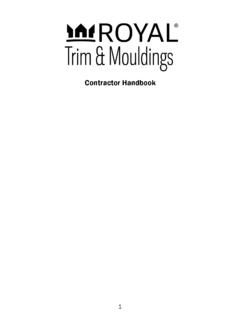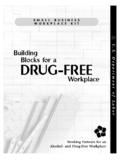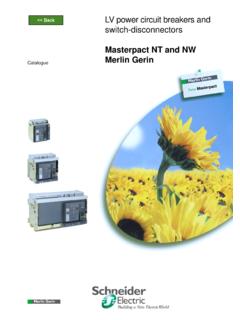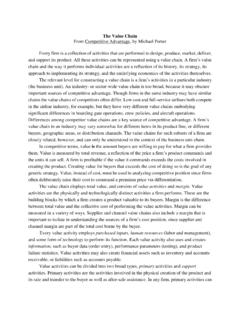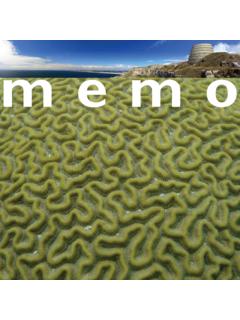Transcription of August 2011 Fisheries USER GUIDE ON PIG HUS- …
1 National Agricultural Advisory ServicesUSER GUIDE ONPIG HUS-BANDRYA ugust 2011 Ministry of Agriculture, Animal Industry and FisheriesPig Husbandry3 NAADS - July 2011 PIG HUSBANDRYPigs are kept for the production of pork and bacon. Most breeds, if properly managed and fed are capable of producing either pork or bacon. The pig industry in Uganda is characterized by low input low-output poorly managed pig production enterprises. Small-scale producers in the rural areas have largely sustained the industry. These producers keep on average 2-5 pigs under very poor hygienic and management conditions. There are just a few commercial pig farmers in the country. Unlike the dairy and beef industries, the pig industry has largely been unable to attract any foreign and internal investment. This has been exacerbated by the high costs of inputs especially in intensive pig production.
2 The major constraints to production include; diseases and parasites, poor breeding, capital investment, inadequate advisory services, inadequate research, lack of organized marketing, lack of processing plants and poor product do we keep pigs? To produce meat fairly quickly and to get some income from it To produce industrial goods such as leather and bristles etc. Pigs produce very high value manure which is useful for enriching our soilWhat are the advantages of pig production? Pigs grow very rapidly from at birth to 90kg in 170 days only Pigs can be raised on small land especially where land holdings are small They produce many young ones. You can raise 20 pigs from one female pig (sow) in a year Pig production has low labour requirements. Pigs are mainly fed on maize and other grains and root tubers which can normally be bought at very low prices during peak seasons of harvesting.
3 Pigs can also be raised on pasture and other crop residues and agro-industrial by products Pigs give quick returns on your investmentCommon Breeds of pigs found in the countrya) Large WhiteIt is white in colour with erect ears and a ditched face. It produces many piglets and is fairly hardyPig Husbandry 4 NAADS - July 2011b) LandraceHas drooping ears, white in colour with long and big body. It has a long straight snout. It is commonly crossed with the large white c) Duroc breedIt is mahogany to red in colour. Has good mothering ability. It is resistant to stress and is adaptable to various environmental conditions. It is very useful in crossbreeding ) CrossesIt is common to find crosses of Largewhite and Landrace. These crosses are very good when used as sows for breedingSelection of pigs for breeding Select good gilts from sows of a superior breed that wean 9-10 piglets per litter and that are known to be good mothers.
4 Selected gilts should have at least 12-14 teats so that a large litter can be easily nursed. Gilts should be healthy with strong legs and well developed body and thigh muscles Beginners in pig farming are advised to start with about 1-2 gilts/sows and progress as more experience and skill is gainedA sample of mature large white Husbandry5 NAADS - July 2011 Management of pigs HousingBefore you venture into pig production decide on the management system you would wish to practice depending on the resources available. Both semi-intensive and intensive systems will require pigs to be is very important in pig production for the following reasons:o It helps in disease and parasite controlo It reduces the labour in husbandry and management tasks like feeding and handlingo It protects the pigs from harsh environmental and climatic conditionso Housing keeps out unnecessary intruderso The pigs are easily observed when housedPig used for construction of a pig housea) Local materials: wooden poles, bamboo poles, grass thatch etc.
5 These are cheap but do not last ) Manufactured/purchased materials: Blocks/bricks, cement, galvanized iron Pig Husbandry 6 NAADS - July 2011sheets etc. These are expensive but are the best to use because they are more long lasting. Whatever material you use for the construction of a pig house it is advisable to use concrete for the floor or to compact the floor hard. Care of the Sow and baby pigsYour pig house should besides the common pens have a farrowing pen (place where the sow delivers). This should be clean, disinfected, dry and warm before farrowing. Leave it for at least 7 days before sow is moved in. Provide fine bedding shavings, sour grass, sawdust, sand or bagasse etc. It should be maintained dry and and of farrowingMany piglets die at this time. Up to 35% of your piglets born alive may die before weaning. The commonest causes of death at this stage are due to:o Crushing of piglets by the mothero Starvationo Born weako Diarrheao Chilling (cold) Husbandry7 NAADS - July 2011 These losses can be minimized by having somebody present at farrowing.
6 Other causes should be identified and precaution taken. Management of pigletso Once farrowing is completed make sure all piglets are nursing. Any excess piglets for the number of functional teats should be transferred to another sow. If there is no other sow, bottle feed with cow s milk sweetened with glucose. Transfer at 3-4 days of age without masking Clip the needle teeth, cut the navel cord leaving about - ( inches) of which should be dipped in a 7% iodine After 2-3 days treat piglets for anaemia with 2-3ml of injectable Provide creep feed at 7 days of age. Change feed Treat with iron again after 2 Deworm after 3-5 weeks and then move sow and piglets to nursery. If litters are mixed in a nursery, litters should not be more than one week difference in age and do not mix more than four litters per Wean at 56 days (8 weeks).o Remember to remove the sow from the piglets and not vice Deworm piglets regularlyo Spray them for lice and mange mites prior to moving them out of nursery at 7-8 Replace the sow after the 6th litter or after 4-5 years of age.
7 If its production is still good, leave it until its production falls below the average of the Seek advice from your extension worker/veterinarian wherever Husbandry 8 NAADS - July 2011 PigletsSuggested targets to achieve Reproduction rate 10-11 pigs born alive per litter 2 litters/sow/year 20-22 pigs born alive/sow/year Survival rate 85% of pigs born alive should be reared to weaning ( Growth rate 90kg liveweight in 170 days with a carcase yield of 77% or 500gms/day over a life time Food conversion efficiency of Aim at marketing the pigs for slaughter as porkers at the age of 4-6 months when they will have attained the weight of 45-65kg Production life span of at most 5 years for the and feedingFeeds take about 70% of the total cost of production. Therefore use feeds efficiently and economically in order to make profit. Use cheaper, lower grade feed stuff and supplement with more nutritious feeds.)
8 Provide feed requirements according to the different categories of pigs and the condition piglets, weaners, growers, pregnant sows and sows, suckling should you feed your pigs? Carbohydrates/Energy feeds: maize, corn, sorghum, cassava, sweet Pig Husbandry9 NAADS - July 2011potatoes (root & vines), banana peels etc. Protein/Body building feeds: bloodmeal (upto 5%), cotton seed meal (upto 10%), fish meal (upto 5%), meat and bone meal (upto 5-10%), milk and milk by-products and soya bean meal (upto 10%), sunflower meal (upto 15%). Minerals: calcium, phosphorus, iron etc Vitamins: These are purchased and added to the feed ration Water: Water must always be available. Water is very important and yet it is always keep your pigs healthy and look out for signs of diseases of pigsDiseaseClinical signsTreatmentControlAfrican swine feverFever, dullness, loss of appetite, huddling together, incoordination, coughing, discolouration of skin to bluish, fluid eye and nose discharges, vomiting and diarrhoeaAttempt control measures onlyRestrict movement of pigs or meat from affected areas.
9 Slaughter of all pigs on the affected farm followed by performance of the pigs with low growth rate, coughing in case of lungwormsAntihelmintics like Levamisol and PiperazineDeworm pigs every three months after weaningMastitis, Metritis and Agalactia (MMA)Sow fails to release milk after farrowing. The udder may be swollen and painfulUse antibiotics and oxytocinGood hygiene in the pig penPiglet anaemiaSigns appear mostly in piglets of 3 weeks of age, pale mucous membranes and skin, dullness and diarrhoeaGive ferrous sulphate injections or oral formulationsPut red soil in pig pen or give iron injection to young pigletsPig Husbandry 10 NAADS - July 2011 Foot and Mouth DiseaseFever and vesicles on the coronate and sometimes on the lips and tongueAdvisable to institute control Slaughter of pigs in the affected houses. vaccinationSwine erysipelasSudden death, loss of appetite, red and bluish appearance of the skin and ears.
10 Diamond shaped skin lesions which may become necroticPenicillin is very effective and is the drug of choiceClean the pen and disinfect. Treat the in contact pigs with and scratching especially at mid-day, scabs on the skin, wrinkling and hardening of the skin, loss of the hair and shaking of the head if the ear is affectedUse Ivomectin (Ivomec), tactic at recommended dosage levelsTreat the pigs whenever they are entering a new pen which has been cleaned and disinfectedLiceLice will be seen in the folds of the skin especially in the neck and at the base of the earsUse insecticides like Ivomec and tactic-acaricideRoutine spraying with tactic or treatment with tacticParakeratosisSimilar signs to those of mange but with no itching and scratchingGive zinc formulations like zinc carbonate or zinc sulphateEnsure that there is enough zinc in the : For details on treatment of these diseases and others, consult a recordsRecords are essential for monitoring both technical and economic efficiency.
